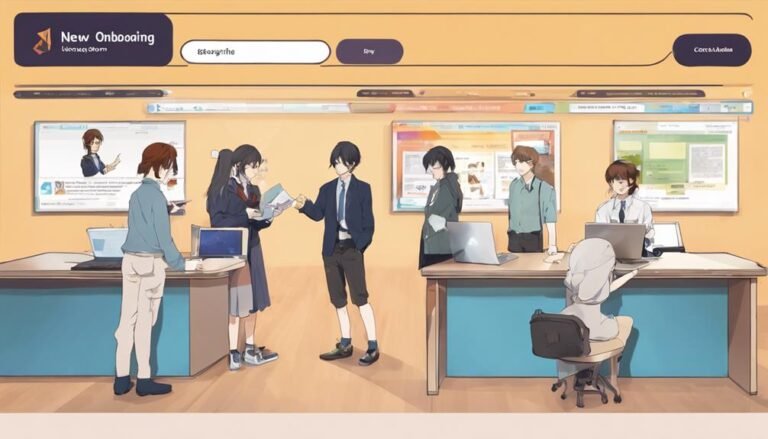What Are the Best Practices for Managing E-Learning Projects and Timelines?
When managing e-learning projects and timelines, it is vital to establish clear objectives, realistic timelines, defined roles, proactive issue resolution, and ongoing evaluation. Setting measurable outcomes and specific goals is essential. Keep stakeholders aligned with SMART objectives. Realistic timelines demand detailed analysis, milestone tracking, and scope management. Establish clear responsibilities, effective communication channels, and feedback loops. Regular progress monitoring and resource allocation are necessary. Be adaptable and proactively resolve issues. Continuously evaluate for improvement. Utilize project management efficiency, stakeholder engagement, and agile methods. Implement these best practices to excel in e-learning project management.
Key Takeaways
- Establish measurable outcomes and specific goals.
- Detailed time estimation and milestone tracking.
- Clearly define roles and responsibilities.
- Regular progress monitoring with feedback loops.
- Efficient resource allocation and task prioritization.
Setting Clear Objectives
Why is setting clear objectives important for successfully managing e-learning projects and timelines?
Establishing measurable outcomes is essential for providing a clear direction and defining what needs to be achieved within the project. By setting specific goals, you can track progress more effectively and guarantee that the project stays on course. Aligning stakeholder expectations is equally important in e-learning projects to make sure that all parties involved understand the objectives and are working towards the same outcomes. When objectives are clearly defined, stakeholders have a common understanding of what success looks like, reducing misunderstandings and potential conflicts down the line.
To effectively manage e-learning projects and timelines, it's essential to establish SMART (Specific, Measurable, Achievable, Relevant, Time-bound) objectives. These objectives provide a roadmap for the project team, guiding their efforts towards the desired outcomes. By setting clear objectives from the start, you can create a solid foundation for the project, increase efficiency, and enhance the overall success of the e-learning initiative.
Establishing Realistic Timelines
Establishing realistic timelines is essential for the successful management of e-learning projects, ensuring that tasks are completed efficiently and within the set timeframe. Time estimation plays a critical role in this process, as it requires a detailed analysis of each task's requirements and the overall project scope. Effective communication is key when determining these timelines, as it involves aligning expectations with stakeholders and team members.
Milestone tracking is another integral aspect of managing e-learning project timelines. By setting specific milestones along the way, you can monitor progress and make necessary adjustments to ensure that the project stays on track. This helps in identifying any potential delays early on and taking corrective actions promptly.
Scope management is also intertwined with establishing realistic timelines. Clearly defining the project scope helps in avoiding scope creep, which can lead to delays and budget overruns. By setting boundaries and managing expectations from the start, you can create a more accurate timeline that accounts for the project's true requirements.
Defining Roles and Responsibilities
Defining and assigning clear roles and responsibilities is crucial for the efficient management of e-learning projects, guaranteeing accountability and clarity throughout the project lifecycle. When each team member knows their role and responsibilities, it fosters teamwork, collaboration, and effective communication.
Engaging stakeholders early on and establishing feedback loops can further enhance project success by aligning expectations and incorporating valuable insights. Here are key points to take into account:
- Clearly Defined Roles: Ensuring each team member understands their specific role and responsibilities.
- Effective Communication Channels: Establishing clear lines of communication to facilitate collaboration and information sharing.
- Stakeholder Engagement: Involving stakeholders from the beginning to gather insights and feedback.
- Feedback Loops: Implementing mechanisms to incorporate feedback and make necessary adjustments.
- Accountability Structures: Setting up systems to track progress, address challenges, and ensure accountability.
Regular Progress Monitoring
For effective project management in e-learning endeavors, consistently monitoring progress is essential to guarantee timely completion and quality outcomes. To secure that your e-learning project stays on track, establishing a feedback loop is key. This loop involves regularly collecting feedback from team members, stakeholders, and learners to assess progress, identify potential issues, and make necessary adjustments. By integrating a feedback loop into your project management approach, you create a mechanism for continuous improvement and course correction.
Additionally, a robust communication plan is critical for effective progress monitoring. Clear and frequent communication among team members helps in tracking milestones, sharing updates, and addressing any bottlenecks promptly. Regular check-ins through virtual meetings, emails, or collaboration platforms keep everyone informed and aligned with project goals. Implementing a structured communication plan ensures that all stakeholders are on the same page and fosters a collaborative environment conducive to project success. By prioritizing regular progress monitoring and incorporating a feedback loop and communication plan, you enhance project efficiency and increase the likelihood of achieving desired outcomes.
Effective Resource Allocation
When managing e-learning projects, it's important to take into account resource availability and task prioritization for effective resource allocation.
By evaluating the resources at hand and aligning them with project needs, you can optimize efficiency and productivity.
Prioritizing tasks based on resource constraints guarantees that critical project elements are addressed promptly, contributing to overall project success.
Resource Availability
To guarantee successful project outcomes in e-learning, efficiently allocating resources is essential for meeting project timelines and objectives. When it comes to resource availability, here are key points to take into account:
- Prioritize tasks based on criticality and dependencies: Make sure that essential tasks are allocated the necessary resources first.
- Regularly assess resource utilization: Monitor resource usage to identify any bottlenecks or excess capacity.
- Consider alternative resource options: Be prepared to adapt and utilize backup resources if needed.
- Communicate effectively with team members: Clear communication helps in understanding resource constraints and availability.
- Adjust resource allocation as needed: Flexibility is key for managing unexpected changes in resource availability.
Task Prioritization
Efficiently prioritizing tasks based on criticality and dependencies is vital for effective resource allocation in managing e-learning projects and timelines.
Time management plays a pivotal role in task prioritization to guarantee that high-priority tasks are completed promptly.
By delegating tasks based on team members' strengths and availability, project efficiency can be maximized.
Team collaboration is key in understanding dependencies between tasks and coordinating efforts to meet project milestones.
When prioritizing tasks, consider the impact of delays on the overall timeline and adjust resources accordingly.
Effective task prioritization not only ensures that essential tasks are completed on time but also fosters a sense of accountability within the team, promoting a culture of efficiency and productivity.
Agile Project Management Techniques
Implement Agile project management techniques to enhance the efficiency and adaptability of e-learning project workflows. Agile methodologies, such as Scrum, can revolutionize the way your team approaches project management. Here's how you can benefit:
- Sprint Planning: Break down your e-learning project into manageable tasks during sprint planning sessions.
- Daily Standups: Conduct brief daily standup meetings to keep everyone updated on progress and discuss any obstacles.
- Iterative Development: Embrace iterative development to continuously improve your e-learning project based on feedback and testing.
- Scrum Framework: Implement the Scrum framework to organize work into sprints, with defined roles and ceremonies.
- Adaptability: Agile methods enable quick adaptation to changes, ensuring your e-learning project stays aligned with evolving requirements.
Proactive Issue Resolution
For effective project management in e-learning, anticipate and address potential issues before they escalate, ensuring smooth progress and timely delivery. Proactive communication is key in resolving issues efficiently.
Encourage team members to communicate openly about any challenges they encounter. By fostering a culture of transparency, you can identify issues early on and work together to find solutions.
Timely escalations are vital when problems arise. If a team member is struggling with a task or if there are technical difficulties, encourage them to escalate the issue promptly. This allows for quick intervention and prevents delays in the project timeline.
Regular check-ins and status updates can also help in identifying any potential issues before they impact the project significantly.
Continuous Evaluation and Improvement
To guarantee the success of your e-learning project, consistently evaluate and enhance its processes and outcomes. Continuous evaluation and improvement are essential for maintaining the quality and effectiveness of your e-learning initiatives.
By implementing performance tracking and feedback loops, you can gather valuable insights into the strengths and weaknesses of your project. This information allows you to make data-driven decisions and improvements to enhance the overall learning experience.
Additionally, adopting iterative development practices enables you to make incremental enhancements based on user feedback, ensuring that your e-learning content remains relevant and engaging. Quality assurance measures should be put in place to maintain high standards and identify any areas that require adjustment.
By prioritizing continuous evaluation and improvement, you can create e-learning projects that deliver maximum impact and value to your learners.
- Performance tracking: Monitor the effectiveness of your e-learning content.
- Feedback loops: Gather input from users to identify areas for improvement.
- Iterative development: Make incremental enhancements based on user feedback.
- Quality assurance: Implement measures to maintain high standards.
- Data-driven decisions: Use insights from evaluations to drive improvements.
Conclusion
To sum up, by setting clear objectives, establishing realistic timelines, defining roles and responsibilities, monitoring progress regularly, allocating resources effectively, utilizing agile project management techniques, resolving issues proactively, and continuously evaluating and improving, you can successfully manage e-learning projects and timelines.
Just like pieces of a puzzle fitting together seamlessly, these best practices work in harmony to guarantee the success of your projects. Stay organized, detail-oriented, and strategic in your approach for best results.







